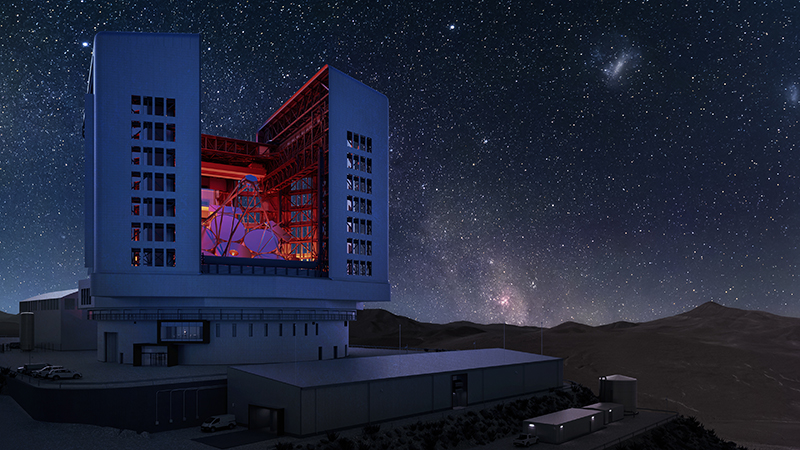
Humanity will soon have a new eye peering out into the universe. Due to start operating in the early 2030s, the Giant Magellan Telescope will look for signs of life on distant planets, investigate the origins of chemical elements, and probe the secrets of the early cosmos.
It will do so using seven of the world’s largest mirrors. Each 8.4m-wide mirror takes four years build, using 17 tonnes of low-expansion glass. Together, they form a 25.4m-wide light collecting surface, the largest of any built telescope. The collected images will be 10-times more detailed than those from Hubble, and four-times those from the James Webb Space Telescope.
There are some seismic challenges, however – an average of six earthquakes a month in the Chilean Atacama Desert. Protecting the mirrors from the frequently powerful shakes requires some extreme engineering.
Yesterday (13 June), engineering and architecture firm Idom gave more detail about its solution – a 22-storey rotating enclosure, now ready for construction after passing its final design review. Weighing over 5,000 tonnes and capable of fully rotating every four minutes, the enclosure will protect the telescope during the day before opening its 46m-tall shutter doors at night, unblocking the view of the clear night sky from Las Campanas Peak, 2,514m above sea level.
“The single biggest challenge is probably maintaining survivability, safety, and operability in the extreme seismic environment,” said Bruce Bigelow, site infrastructure, enclosure and facilities manager, to Professional Engineering.
The design will provide seismic resilience thanks to careful application of mass and geometry to the structure’s beams and the joints between them, Bigelow said. The goal is to keep the seismic structural performance in the ‘elastic’ regime, meaning it will be able to flex under seismic loads without experiencing permanent deformations.
Elasticity is especially important for ensuring that the mechanisms that rotate and open/close the enclosure will still function safely after large earthquakes, up to eight on the surface-wave magnitude scale (MS).
“Without seismic protection, it’s very likely that a 25m-class telescope would not survive, much less return to normal operation, after a very large earthquake. The last generation of 8-10m-class telescopes, when subjected to large earthquakes, have sustained serious damage that required months to repair. The factor of roughly three increase in size for the extremely large telescopes further amplifies the risk of serious seismic damage,” said Bigelow.
“To mitigate the seismic risk, the Giant Magellan Telescope uses a seismic isolation system (SIS) between the foundations and the telescope pier. The SIS uses a circular array of seismic bearings which allow the ground to move laterally under the telescope, hence ‘isolating’ direct transmission of the sideways ground motions to the telescope.”
An additional hydraulic system in the telescope provides enhanced protection from vertical ground movements, providing “three-dimensional protection” from seismic events.
Bigelow continued: “This is an approach that has been adapted from similar designs for conventional structures (buildings, bridges, fuel tanks) in seismically active areas. But it’s trickier than it sounds, as the SIS must be stable enough to allow precise operation of the telescope in normal conditions, but flexible enough to protect the telescope during an earthquake.”
Seeing stars
After the risk of earthquake damage, Bigelow said the second biggest challenge – common to nearly all telescope enclosures – is providing effective environmental protection during the day and during bad weather, without negatively affecting the image quality provided by the telescope at night.
The team met this challenge by using stronger beams and diagonal bracing than would be required for a conventional structure of a similar size, Bigelow said. The horizontally sliding doors also latch to each other when closed, improving the combined integrity of the structure.
Other challenges include the remoteness and elevation of the observatory site, high winds on the mountain peak, and the sheer size of the telescope compared to previous projects.
To meet the high demands that will be placed on it, the enclosure design needs to strike a balance between immense strength and precision, making sure it does not interfere with the telescope as it targets and tracks celestial objects. This will involve a low friction ‘turntable’ rotation system, Bigelow said, with 33 ‘bogies’ carrying the mass of the enclosure and guiding its rotation. Two wheels on each bogie are driven by gearmotors and coordinated by a computerised control system to provide the necessary precision in angular position and velocity.
Being built by an American-led international consortium of 14 universities and research institutions, construction of the telescope components is advancing rapidly, the project said. Fabrication commenced on the final primary mirror in Arizona in the last year, while manufacturing of the 39m-tall mount structure began in Illinois. Other advancements include near completion of the telescope’s first adaptive secondary mirror, and significant progress on a suite of high-resolution imagers and spectrographs in Arizona, California, Massachusetts, and Texas.
“These optical technologies will enable the Giant Magellan to boast a remarkable tenfold increase in resolution compared to the Hubble Space Telescope and deliver up to 200-times the power of today’s best telescopes,” yesterday’s announcement said. “The breakthrough technologies will empower scientists worldwide, offering unparalleled insights into the evolution of the universe, the origins of chemical elements, and the discovery of life on distant exoplanets for the first time.”
Want the best engineering stories delivered straight to your inbox? The Professional Engineering newsletter gives you vital updates on the most cutting-edge engineering and exciting new job opportunities. To sign up, click here.
Content published by Professional Engineering does not necessarily represent the views of the Institution of Mechanical Engineers.

